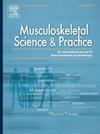Relative contribution of real/sham spinal manipulation performance, changes in cortisol levels, and patient expectations and fear behaviors in modulating short-term pain relief in people with neck pain: A secondary analysis of a randomized clinical trial
IF 2.2
3区 医学
Q1 REHABILITATION
引用次数: 0
Abstract
Background
Spinal manipulation (SM) is a widely practiced, hands-on, non-invasive manual therapy aimed at alleviating musculoskeletal pain and improving functional capacity. Although the clinical effects of this intervention are well known, most reviews conclude that the underlying mechanisms needs further investigation. Therefore, the aim of this study was to analyze the individual contribution of SM execution, expectations, fear behaviors and neuroendocrine changes on short-term pain intensity variance following the interventions.
Design
Experimental study.
Methods
A secondary analysis from a previous randomized clinical trial was conducted. Sixty-two patients were randomized for two factors: the intervention assigned (cervical manipulation and sham manipulation) and the induced expectations (positive, neutral and negative) during treatment. A linear regression analysis was conducted to calculate the individual contribution of the SM execution (sham/real), expectations conditioning (positive/negative/neutral), fear behaviors (fear/no fear) and neuroendocrine changes (salivary cortisol) on the variance of immediate pain intensity changes (pre-post intervention difference) following the single intervention.
Results
Changes in salivary cortisol (β = −0.027, p = 0.838) and fear (β = −0.192, p = 0.135) were not significant explanatory variables of pain intensity response (p > 0.05). However, verbally-induced expectations (β = 0.722, p < 0.001) and the manipulation execution (β = 0.207, p = 0.019) showed a significant positive association with pain intensity response, suggesting that positive expectations had a meaningful impact on reducing pain intensity and a real intervention may involve specific hypoalgesic responses.
Conclusion
Clinicians should consider that patients' expectations may influence clinical outcomes. Verbally expressing positive or neutral expectations may improve pain-related outcomes, whereas conveying negative expectations could diminish the treatment's effectiveness.
真实/虚假脊柱操作表现、皮质醇水平变化、患者期望和恐惧行为在调节颈部疼痛患者短期疼痛缓解中的相对贡献:一项随机临床试验的二次分析
脊柱操作(SM)是一种广泛实践的,动手的,非侵入性的手工治疗,旨在减轻肌肉骨骼疼痛和提高功能能力。虽然这种干预的临床效果是众所周知的,但大多数综述认为其潜在机制需要进一步研究。因此,本研究的目的是分析SM执行、期望、恐惧行为和神经内分泌变化对干预后短期疼痛强度方差的个体贡献。DesignExperimental研究。方法对先前的随机临床试验进行二次分析。62例患者随机分为两个因素:指定的干预措施(颈椎手法和假手法)和治疗期间诱导的期望(积极、中性和消极)。通过线性回归分析,计算单干预后SM执行(假/真)、期望条件反射(积极/消极/中性)、恐惧行为(害怕/不害怕)和神经内分泌变化(唾液皮质醇)对即时疼痛强度变化方差(干预前后差异)的个体贡献。结果唾液皮质醇(β = - 0.027, p = 0.838)和恐惧(β = - 0.192, p = 0.135)变化不是疼痛强度反应的显著解释变量(p > 0.05)。然而,言语诱导的期望(β = 0.722, p < 0.001)和操作执行(β = 0.207, p = 0.019)与疼痛强度反应显着正相关,这表明积极期望对减轻疼痛强度有显著影响,真正的干预可能涉及特定的镇痛反应。结论临床医生应考虑患者的期望可能会影响临床结果。口头表达积极或中立的期望可能会改善疼痛相关的结果,而传达消极的期望可能会降低治疗的有效性。
本文章由计算机程序翻译,如有差异,请以英文原文为准。
求助全文
约1分钟内获得全文
求助全文
来源期刊

Musculoskeletal Science and Practice
Health Professions-Physical Therapy, Sports Therapy and Rehabilitation
CiteScore
4.10
自引率
8.70%
发文量
152
审稿时长
48 days
期刊介绍:
Musculoskeletal Science & Practice, international journal of musculoskeletal physiotherapy, is a peer-reviewed international journal (previously Manual Therapy), publishing high quality original research, review and Masterclass articles that contribute to improving the clinical understanding of appropriate care processes for musculoskeletal disorders. The journal publishes articles that influence or add to the body of evidence on diagnostic and therapeutic processes, patient centered care, guidelines for musculoskeletal therapeutics and theoretical models that support developments in assessment, diagnosis, clinical reasoning and interventions.
 求助内容:
求助内容: 应助结果提醒方式:
应助结果提醒方式:


